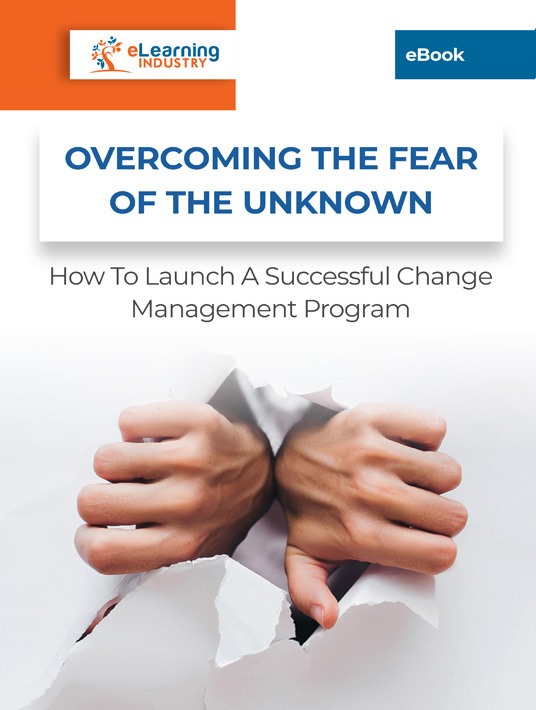How To Evaluate Your Change Management Process
Change is difficult. Whether you’re phasing out a job title or expanding to different markets, your employees need to know what to expect and the role they play in this new business venture. This requires an effective change management online training program that is emotionally-centered and results-driven. How do you know if your current process aligns with your business needs and employee expectations? Are there any resources missing from your support online training library? How can you encourage employees to become more involved in the transition and make them feel included? Here are 6 top tips to help you analyze your change management process and make the necessary modifications.

1. Clarify And Reevaluate Your Objectives
First things first, make sure your training objectives still align with the company post-change. As you transition, it’s time to take a closer look at your goals and desired outcomes. You also need to sift through outdated objective statements. Do they reflect your new company vision? Do they include measurable outcomes so that you can track your road to a successful business transformation?
2. Collect eLearning Feedback From Employees
Lack of control could cost you top talent. Employees already know that change is coming and must prepare for all the stresses that accompany it. However, giving them a voice can keep them in the loop. Collect eLearning feedback to get their thoughts about the current change management process and identify areas for improvement. Do they feel like their opinions count and that team leaders offer enough support? Could they benefit from more Just-In-Time online training tools to bring them up to speed? What about group collaboration and peer-based support opportunities?
3. Evaluate LMS Metrics
Now that you’ve tackled the human part of the equation, look at your LMS metrics. Are specific online training tools more popular than others? What are the employee engagement and completion stats? LMS analytics tell you a lot about what’s missing from your current online training strategy and how to adjust the course moving forward. For example, only a handful of employees still access your safety online training video, which indicates that it’s not relevant or that you need to boost your in-house marketing efforts. Keep in mind that change management plans should always be in flux. Online training resources must adjust to meet the needs of the employees and reflect new organizational processes. LMS metrics help you zero in on underperforming assets and disclose employee preferences.
4. Get Input From Team Leadership
Team leaders are in the thick of things. They interact with employees daily and understand their unique requirements and concerns about the upcoming change. So, get their input to improve the process and build your online training strategy. If they are team leaders who are leaving your company, conduct surveys to gather eLearning feedback. Live events and social media groups are a great way to tap into the knowledge base of your current management staff. For new team leadership, invite them to share their thoughts and ideas about future online training resources and activities that can help ease employees into change management and ensure that everyone is on the same page.
5. Pre-Assess To Pinpoint Gaps
An effective change management process targets pre-existing gaps that might carry over to new business practices. For example, employees lack skills that may be useful for new tasks or compliance protocols. As such, you should pre-assess to identify personal areas for improvement and update your training objectives accordingly. Then again, there may be some gaps that are no longer relevant. For instance, an employee struggles with the current sales process, but the new steps are easier to master. You no longer have to worry about their performance inefficiencies because the change makes things more intuitive and user-friendly. In fact, that’s one of the primary reasons why you’ve decided to launch this change within the organization.
6. Hire An Outsourcing Partner For Training Needs Analysis
Many companies fumble through changes because they lack the necessary experience or resources. Thus, they’re less likely to transform business processes in the future due to the stresses of the past, even if the change will help their company evolve and keep up with competitors. An eLearning content provider specializing in Training Needs Analysis can guide you through change management evaluation and provide a fresh perspective. They’re outsiders looking in, which gives them a unique vantage point. They’re able to see what works, what doesn’t, and how to fix the problem cost-effectively. Here are a few benefits an outsourcing partner brings to the table:
- Analytical tools and experience to help you disclose hidden gaps and develop new strategies.
- Improved L&D ROI by rooting out online training practices that no longer serve your organization or hinder employee buy-in.
- Free up company resources (and payroll hours) so that your L&D department can focus on other tasks.
Tap into their vast experience in the industry to streamline your online training strategy. For example, they’ve worked with numerous businesses in your niche and understand the emotional factors you must consider, as well as compliance issues that impact change management.
Methods Of Measurement
Measuring change management involves more than just monitoring business KPIs. Below, we provide a few methods to measure change management effectiveness:
1. Pay Attention To Readiness And Awareness
Awareness and readiness are two fundamental markers of change management performance. Preparedness measures if personnel have the abilities and resources to embrace the change, and awareness measures whether they comprehend its nature and goal.
Focus groups and staff surveys can determine awareness at various transition phases. Test results, training attendance, help desk metrics, and usage records can also be examined to determine whether staff members can execute the change.
2. Quantify Data If Possible
Use Likert scales (e.g., 1 to 5) to monitor emotions and spot patterns when framing survey questions. Help desk statistics, including ticket volume by issue type, can also reveal areas of confusion or frustration for staff members.
3. Give Managers The Authority To Track Team Development
Managers are responsible for reinforcing change. Urge them to monitor whether team members are implementing new procedures or utilizing new technologies. Provide managers with background information, such as recurring queries or support difficulties, so they can better assist team members and deal with bottlenecks early.
4. Assess The Readiness Of The Organization
Determine whether your business is ready before implementing workforce changes. This involves determining whether stakeholder groups, systems, and procedures can support the shift and ensure change management effectiveness.
5. Monitor The Effect Of Communication
Utilize technological tools to track how employees are responding to messages about change. Email open rates, video views, and content engagement can all be monitored via internal platforms. Feedback elements, like comments or upvotes, can be used to determine which messages are most beneficial.
6. Create Ongoing Feedback Loops
Gather information at every stage of the process through focus groups, surveys, and support ticket analysis. Close the loop by explaining how the input influenced the choices; this openness promotes responsibility and inspires further involvement.
7. Assess Adoption Over Time
After installation, monitor performance indicators and behavior to determine whether the change has "stuck."
Managing Change Effectively
Effective change management includes leading your team through ambiguity with clarity, compassion, and encouragement. Here are some ways to go about it:
1. Clear, Consistent Communication
Maintaining honest and open communication with staff members is essential. Even when there isn't much news, share updates frequently. Describe the rationale behind choices and solicit input. Your team will know their problems are significant if you listen and follow up.
2. Team Involvement
Staff members should be involved in the change process to lessen opposition. Involve people in the creation of new processes, get their opinions, and discuss how changes impact their responsibilities.
3. Make Priorities and Roles Clear
Change frequently leads to misunderstandings about roles. Evaluate responsibilities, establish clear expectations, and ensure everyone knows their duties and how they contribute to the team's objectives.
4. Provide Assistance
Recognize that everyone responds to change differently. Recognize emotional reactions and offer both emotional and practical assistance. Encourage candid discussions, point your team toward helpful resources, and allow them time to adjust, particularly to new technologies or systems.
5. Manage Yourself
Remain composed and self-aware, seek coaching or mentoring if necessary, and offer support. Your team will be more inclined to follow you if you lead with an example.
Conclusion
Change is rarely easy. It’s not the idea of new processes or rules that puts employees on edge, but the unknown roadblocks that accompany them. Evaluating your current plan can eliminate obstacles that stand in the way of company-wide change. It also helps you consider the emotional state of your staffers and how the transition will impact their everyday lives. So, get their input, evaluate your metrics, and enlist the aid of an outsourcing partner to guide you through the process.
Every organization must endure change from time to time, and this can be frightening. Download the eBook Overcoming The Fear Of The Unknown: How To Launch A Successful Change Management Program to discover how to launch a change management program that is destined to be a roaring success.









